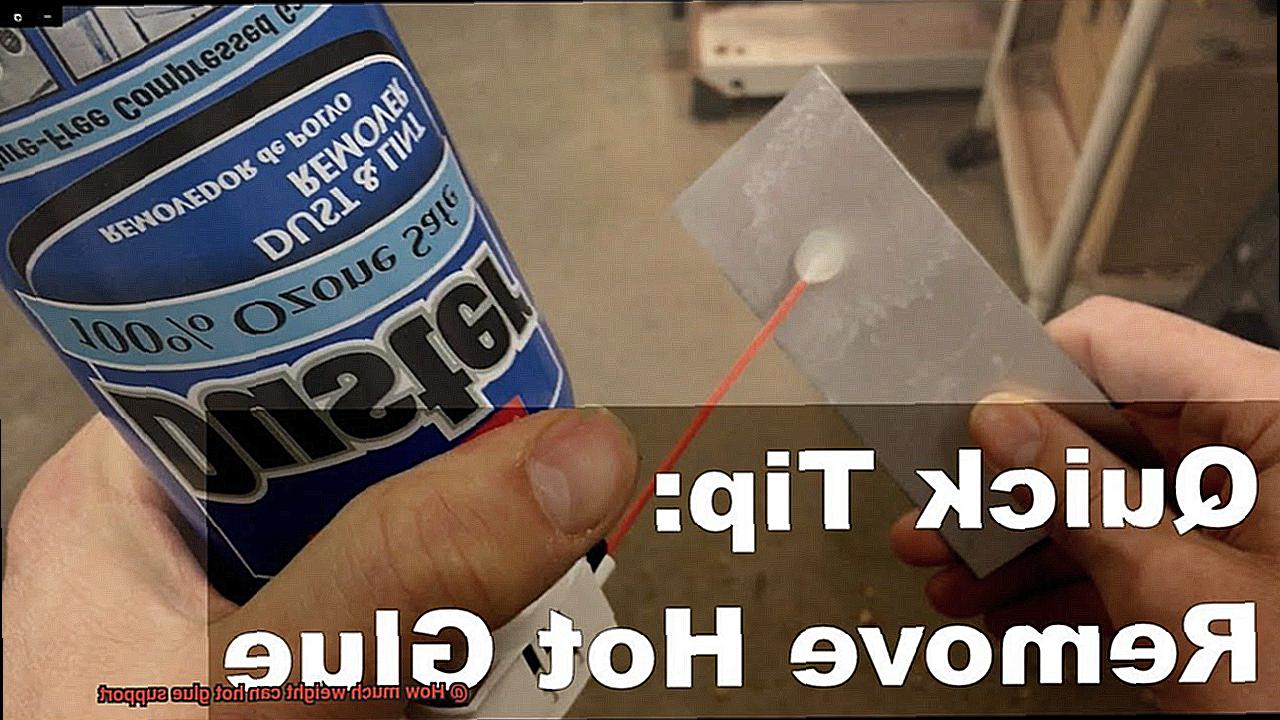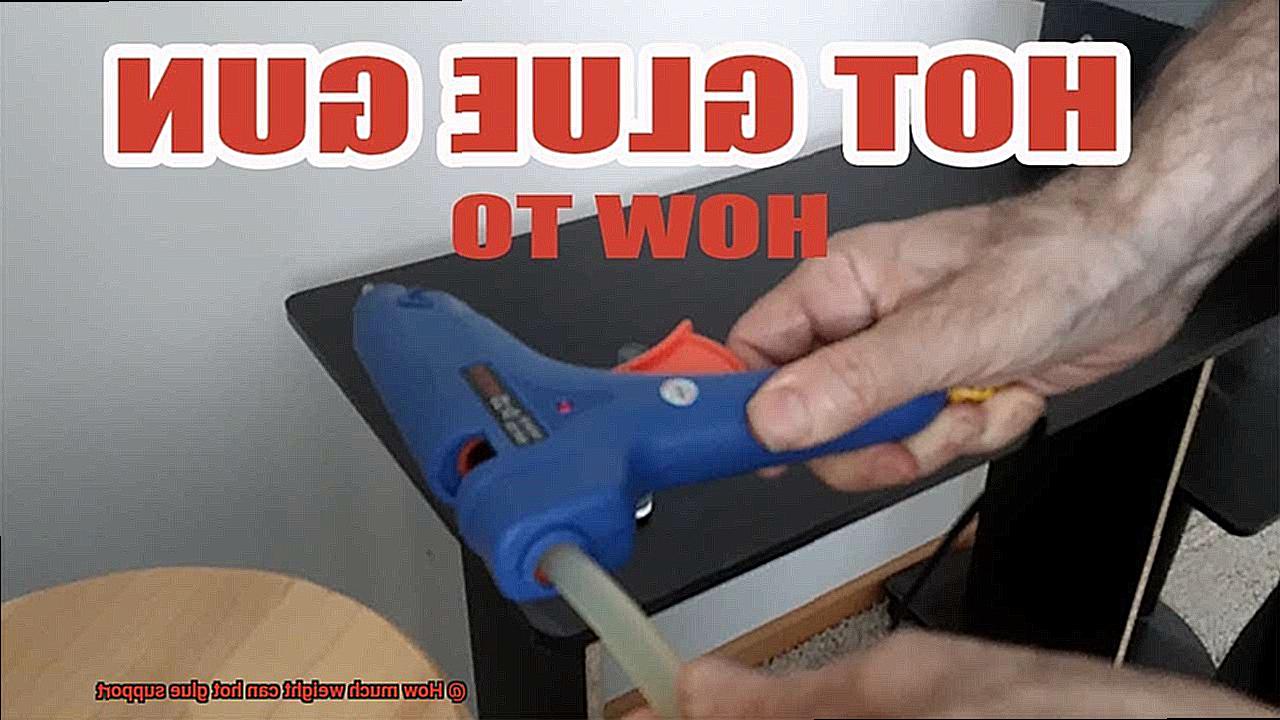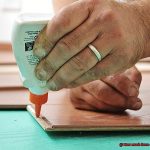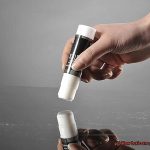Hot glue, that magical adhesive found in every DIY enthusiast’s toolbox.
It’s the go-to solution for arts and crafts projects, home repairs, and everything in between. But have you ever wondered just how much weight this sticky wonder can support?
Whether you’re hanging up decorations or building a tiny model, knowing the limits of hot glue is crucial. In this blog post, we’ll dive into the world of hot glue and explore its strength and capabilities.
We’ll uncover its tensile and shear strength, as well as its limitations. So if you’re ready to unleash the full potential of hot glue, join me on this journey of discovery.
Let’s find out just how far we can push this adhesive superhero.
What is Hot Glue?
Contents
- 1 What is Hot Glue?
- 2 Factors that Determine the Weight-Bearing Capacity of Hot Glue
- 3 Hot Glue Strength for Lightweight Objects
- 4 Hot Glue Strength for Heavier Objects
- 5 When to Use Mechanical Fasteners Instead of Hot Glue
- 6 External Factors That Impact the Weight-Bearing Capacity of Hot Glue
- 7 Tips and Techniques to Maximize the Strength and Durability of Hot Glue Bonds
- 8 Specialized Hot Glues for Heavy-Duty Applications
- 9 Conclusion
Its ability to bond various materials quickly and securely makes it a go-to choice for countless projects. However, understanding its limitations and employing proper techniques can make all the difference when it comes to successful adhesion. In this comprehensive guide, we will explore the concept of hot glue, how it works, its applications, and provide valuable tips for maximizing its potential.
Understanding Hot Glue:
Hot glue is a thermoplastic adhesive that is applied in a molten state and quickly solidifies as it cools down. Sold in cylindrical sticks or pellets that are loaded into a hot glue gun, the glue is heated to a temperature where it becomes liquid and easily dispensed. Once applied to the desired surface, it rapidly cools and forms a strong bond between the materials being joined.
Applications and Advantages:
Hot glue’s versatility is one of its greatest strengths. It can bond a wide variety of materials including wood, plastic, fabric, paper, ceramics, and even certain metals. This makes it an ideal choice for crafts, DIY projects, repairs, and industrial applications where different materials need to be joined together.
Hot glue offers several advantages over other adhesives. It has a relatively fast curing time, typically setting within minutes, allowing for efficient assembly and completion of projects. Additionally, hot glue can withstand different temperatures, remaining stable and secure in both high-temperature and low-temperature environments. This makes it suitable for applications exposed to extreme heat or cold.
Tips for Successful Adhesion:
To ensure optimal bonding strength with hot glue:
- Prepare the surface by cleaning it thoroughly to remove any dirt, grease, or loose particles that may hinder adhesion.
- Aim for a consistent and even application of hot glue, avoiding excessive or insufficient amounts that can compromise the bond’s integrity.
- Allow the hot glue to fully cure before subjecting it to stress. While it sets quickly, its strength continues to increase over time, ensuring maximum durability.
- For applications requiring extra strength, consider applying multiple layers or thicker beads of hot glue to increase the surface area of adhesive contact.
- Choose the right formulation for your project’s needs. Standard hot glues are suitable for lightweight projects, while industrial-grade formulations offer enhanced adhesion and higher weight-bearing capacities.
- Consider environmental factors such as extreme heat or high moisture levels that may affect hot glue’s performance. Select an adhesive that can withstand these challenges.

Factors that Determine the Weight-Bearing Capacity of Hot Glue
Not all hot glues are created equal in terms of weight-bearing capacity. In this exploration of the factors that determine hot glue’s weight-bearing capacity, we will delve into the intricate details that shape this adhesive’s strength, enabling you to make informed decisions for your next project.
Type of Hot Glue:
- Low-temperature glue: Ideal for lightweight applications such as crafts and decorations.
- High-temperature glue: Boasts stronger adhesive properties, suitable for medium-weight objects.
- Industrial-strength glue: Engineered to hold heavy objects and endure extreme conditions.
Surface Material:
- Porous surfaces: Wood and fabric provide an excellent bond with hot glue.
- Non-porous surfaces: Metals, glass, and plastics may require special formulations or surface preparation to achieve effective bonding.
Application Method:
- Adequate Coverage: Apply enough hot glue to ensure sufficient contact between the surfaces being joined.
- Dispensing Temperature: Follow manufacturer recommendations to optimize adhesive strength.
- Application Speed: Apply the hot glue evenly, taking your time to avoid gaps or excess glue.
Cure Time:
- Rapid Setting Time: Hot glue bonds quickly but may require additional curing time for maximum strength.
- Follow Manufacturer Instructions: Adhere to the recommended cure time for optimal bonding performance.
Environmental Conditions:
- Temperature: Extreme heat or cold can weaken hot glue’s adhesive properties.
- Humidity: High humidity levels can also impair its effectiveness.
Weight Distribution:

- Even Weight Distribution: Ensuring weight is evenly distributed across the glued area maximizes strength.
- Avoid Concentrated Stress Points: Uneven weight distribution or stress on small areas can weaken the bond.
Hot Glue Strength for Lightweight Objects
Hot glue, the unsung hero of the crafting and DIY world, possesses an unparalleled strength when it comes to bonding lightweight objects. Its ability to quickly and securely adhere materials has made it a go-to adhesive for countless projects.
But what makes hot glue so formidable? In this article, we’ll delve into the science behind hot glue’s strength, exploring the impact of material type, temperature, thickness, and quantity on its adhesive prowess.
Material Matters:

Hot glue exhibits its greatest strength on porous surfaces like fabric, paper, and wood. These materials provide an expansive surface area for the glue to grip onto, resulting in a bond that can withstand the test of time.
Conversely, smooth or non-porous materials such as glass or metal present a more slippery challenge for hot glue, making it less effective in supporting weight. When selecting hot glue for your lightweight project, always consider the material’s porosity.
Temperature Triumphs:
The temperature at which hot glue is applied plays a vital role in determining its strength. With a melting point ranging from 250°F to 380°F (121°C to 193°C), hot glue’s true potential is unleashed when it is applied at higher temperatures.
The heat allows the glue to flow freely and seep into the materials, creating a bond that can weather any storm. However, caution must be exercised to avoid excessive heat that could weaken certain materials or cause unwanted deformation.
Thickness and Quantity:
Thicker layers of hot glue boast superior strength due to their increased surface area for bonding. The more contact between the adhesive and the materials being joined, the stronger the hold. Enhancing the bond further can be achieved by layering multiple applications or fortifying the joint with additional adhesive reinforcement. But beware. The line between adequate and excessive glue can be thin. Over-applying hot glue may result in uneven surfaces that compromise the bond.
Weighing the Limitations:
While hot glue is a heavyweight champion for lightweight objects, its strength diminishes when faced with heavy or load-bearing applications. This adhesive marvel isn’t designed to withstand prolonged stress or significant weight. If you’re grappling with heavier objects or seeking a more durable bond, it’s time to explore alternative adhesives like epoxy or construction adhesives tailored for such demanding tasks.
Hot Glue Strength for Heavier Objects
Hot glue, a beloved adhesive in the world of crafting and DIY, has gained a reputation for its versatility and ease of use. But what about its strength when it comes to supporting heavier objects? In this comprehensive exploration, we will delve into the intricacies of hot glue’s power and limitations.
Firstly, it is essential to understand that the strength of hot glue hinges on various factors. The type and brand of glue, the surface it adheres to, and the weight and size of the object all play significant roles. Generally speaking, hot glue is not recommended for heavy-duty applications or long-term durability. Its true prowess lies in bonding lightweight materials such as paper, fabric, and lightweight plastics.
However, do not despair if you desire to utilize hot glue for heavier objects. There are ways to enhance its strength through additional support or reinforcement. One effective method is to create a larger surface area for the glue to bond by roughening or sanding the surfaces being joined. This technique increases the contact area between the glue and the object, resulting in a stronger bond.
Temperature also plays a vital role in hot glue’s strength. It is crucial to use it within its recommended temperature range for optimal performance. Going too low weakens the bond, while excessively high temperatures can damage certain materials.
Prior to embarking on your project, I highly recommend testing the strength of hot glue first. Apply a small amount onto a similar material and subject it to a weight or stress test. This will provide invaluable insight into how well the hot glue will hold up under comparable conditions.
Nevertheless, let us acknowledge that sometimes hot glue alone may not suffice. In such instances, do not hesitate to explore alternative adhesives or mechanical fasteners like screws, nails, or brackets. These reinforcements can lend that extra support required to ensure stability and longevity.
When to Use Mechanical Fasteners Instead of Hot Glue
Hot glue is a beloved adhesive in the crafting world, but there are instances where its strength and longevity may fall short. In these cases, mechanical fasteners like screws, nails, bolts, and rivets step in to offer superior stability and long-lasting bonds. So, when should you opt for mechanical fasteners over hot glue? Let’s delve into the details.
Heavy Load-Bearing Applications:
When dealing with materials that will bear substantial weights or experience significant stress, mechanical fasteners reign supreme. Woodworking projects or metal constructions greatly benefit from the added strength and durability that screws or bolts provide. These steadfast fasteners ensure your creations withstand the test of time.
Longevity and Durability:
Projects that call for a secure and permanent bond demand the resilience offered by mechanical fasteners. They excel in high-stress applications, promising greater durability for your creations. Unlike hot glue, which may loosen or weaken over time, mechanical fasteners provide enduring strength.
Temperature Resistance:
Hot glue has its limitations in extreme temperatures. Under high heat, it can soften or melt, jeopardizing the bond it forms. Mechanical fasteners, however, remain unaffected by temperature changes and can endure scorching heat or freezing cold without compromising their integrity.
Frequent Disassembly or Repositioning:
In cases where frequent disassembly or repositioning is necessary, mechanical fasteners prove their worth. They allow for easy removal and reassembly without causing damage to the materials involved. Unlike hot glue, which can leave behind residue or damage surfaces upon removal, mechanical fasteners offer convenience and versatility.
Uneven or Irregular Surfaces:
Joining materials with uneven or irregular surfaces can pose a challenge for adhesives like hot glue. Mechanical fasteners provide a reliable connection by penetrating into the material, creating a secure grip that hot glue may struggle to achieve. This makes them ideal for projects involving uneven or irregular surfaces.
Structural Stability:
Applications that involve lateral forces or vibrations demand superior structural stability. Mechanical fasteners, with their robust grip and resistance to external forces, outperform hot glue in these scenarios. They can withstand the rigors of lateral forces and vibrations, preventing joint failure and ensuring long-lasting stability.
External Factors That Impact the Weight-Bearing Capacity of Hot Glue
Hot glue is a remarkable adhesive, widely used in crafts and DIY projects. To create strong and dependable bonds, it is essential to understand the external factors that influence its weight-bearing capacity. In this article, we will delve into how temperature, humidity, surface material, surface texture, application technique, and curing time all play crucial roles in determining the strength of hot glue bonds.
Temperature:
Extreme temperatures can greatly affect the performance of hot glue. Cold temperatures make it brittle and less adhesive, while excessive heat causes it to soften or melt. Stick to the recommended temperature range of 350°F to 450°F for optimal results.
Humidity:
The level of humidity in the environment impacts the drying process of hot glue. High humidity slows down drying, resulting in weaker bonds. Conversely, low humidity accelerates drying, allowing hot glue to reach its full strength and support heavier loads.
Surface Material:
Hot glue adheres best to porous surfaces like wood and fabric, forming strong bonds that support significant weight. However, non-porous surfaces such as glass or metal may result in weaker bonds and reduced weight-bearing capacity.
Surface Texture:
The texture of the surface plays a vital role in how well hot glue adheres and supports weight. Rough or uneven surfaces offer more grip for the adhesive, resulting in stronger bonds. Smooth surfaces provide less grip, leading to weaker bonds and decreased weight-bearing capacity.
Application Technique:
Applying hot glue evenly across the entire surface ensures better weight distribution and increases overall bond strength. Insufficient or uneven application can create weak spots that compromise the weight-bearing capacity.
Curing Time:
Hot glue requires sufficient time to cure and reach its maximum strength. During this process, chemical changes occur that enhance durability and load-bearing capabilities. Allow adequate curing time before subjecting the adhesive to stress or weight.
Tips and Techniques to Maximize the Strength and Durability of Hot Glue Bonds
Hot glue is a versatile adhesive that is commonly used in various projects, but maximizing the strength and durability of hot glue bonds is crucial for ensuring project success. In this article, we will explore five key tips and techniques to help you achieve stronger and longer-lasting hot glue bonds. Let’s dive in.
Cleanliness is Key:
One of the most important factors in achieving strong hot glue bonds is ensuring that the surfaces being bonded are clean and free from any debris or oils. Before applying hot glue, thoroughly clean the surfaces with a mild detergent or rubbing alcohol to remove any contaminants that could weaken the bond. This step will help promote better adhesion and improve the overall strength of the bond.
Temperature Control:
Temperature control plays a vital role in maximizing the strength of hot glue bonds. Different materials require different temperature settings for optimal bonding. Adjust the temperature on your hot glue gun accordingly – higher temperatures for metals and glass, and lower temperatures for delicate materials like foam or fabric. By using the correct temperature, you can ensure that the hot glue properly melts and adheres to the surfaces, resulting in stronger and more durable bonds.
Steady Hand, Steady Pressure:
Applying hot glue evenly and in a controlled manner is crucial for achieving strong bonds. When applying the hot glue, use a steady hand and apply steady pressure throughout the process. Avoid rushing or applying excessive amounts of glue, as this can result in uneven distribution and weak bonds. Instead, maintain a slow and continuous motion when dispensing the glue to ensure an even distribution of adhesive.
Reinforce for Added Strength:
For projects that require extra strength, consider reinforcing your hot glue bonds with additional support or mechanical fasteners. While hot glue alone can provide sufficient strength for many applications, incorporating screws, clamps, or other forms of reinforcement can significantly enhance the bond’s durability. This is particularly important when bonding materials like wood, where the added support can help withstand heavy loads or stress.
Patience is a Virtue:
Allowing sufficient curing time is essential for maximizing the strength and durability of hot glue bonds. While hot glue bonds may initially feel strong, they require time to reach their full strength. It is generally recommended to let the bond set for at least 24 hours before subjecting it to any significant stress or load. Patience during the curing process will result in stronger and longer-lasting bonds.
Specialized Hot Glues for Heavy-Duty Applications
Specialized hot glues for heavy-duty applications are designed to withstand the toughest conditions and provide a reliable bond. These glues are formulated with specific additives and ingredients that give them extra strength and durability. To ensure a strong bond, proper surface preparation and application techniques are crucial.
Here are some key points to consider:
- Surface preparation: Clean surfaces thoroughly to remove dirt, dust, and contaminants. Use a degreaser or rubbing alcohol to remove oily or greasy substances. Roughen smooth surfaces with sandpaper or a wire brush to improve adhesion.
- Glue application: Apply an even and generous amount of glue for a strong bond. Consider using multiple layers or beads of glue for heavy objects to distribute the weight evenly.
- Additional reinforcement: While specialized hot glues are generally stronger than regular hot glues, they may not be suitable for all heavy-duty applications. In some cases, mechanical fasteners such as screws or bolts may be necessary for additional strength and stability.
- Curing process: Exercise patience during the curing process as hot glue needs time to cool and harden before reaching its full strength. Avoid testing the bond too soon.
5mNAkxqhXiI” >
Also Read: How Much Weight Can Hot Glue Hold?
Conclusion
Hot glue may seem like a weak adhesive, but don’t be fooled by its innocent appearance. This versatile adhesive has the potential to support surprising amounts of weight. Whether you’re crafting, repairing, or creating DIY projects, hot glue can be your secret weapon in securing objects together.
But just how much weight can hot glue support? Well, it depends on various factors such as the type and quality of the hot glue used, the surface materials being bonded, and the distribution of weight. In general, high-quality hot glue sticks have a tensile strength ranging from 15 to 30 pounds per square inch (psi).
To put this into perspective, imagine a small decorative shelf made of lightweight wood. With the right application of hot glue and proper surface preparation, it could easily hold up to 10 pounds of weight without breaking a sweat.
However, it’s important to note that hot glue is not suitable for heavy-duty applications or load-bearing structures. It excels in providing temporary or light-duty bonds that can withstand everyday use and moderate stress.
So next time you’re working on a project and wondering if hot glue can handle the job, rest assured that it’s more capable than you might think. Just remember to choose the right type of hot glue for your specific needs and follow proper application techniques for optimal results.
In conclusion, while hot glue may not be able to lift cars or support massive weights like industrial adhesives do, it is still a reliable choice for countless creative endeavors.






